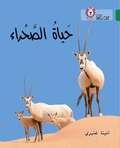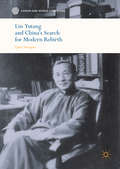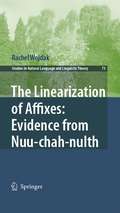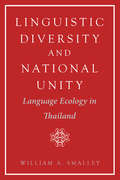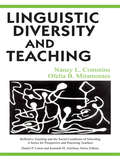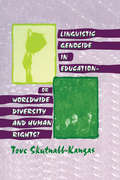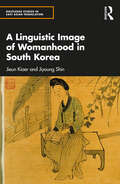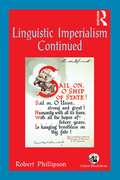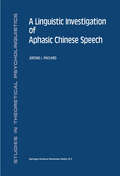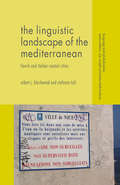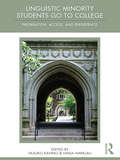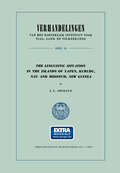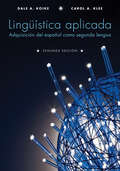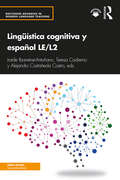- Table View
- List View
The Life Of The Desert: Level 15 (Collins Big Cat Arabic Reading Programme Ser.)
by Anita Ganeri Collins Big CatLikenesses: Translation, Illustration, Interpretation
by Matthew ReynoldsTranslation, illustration and interpretation have at least two things in common. They all begin when sense is made in the act of reading: that is where illustrative images and explanatory words begin to form. And they all ask to be understood in relation to the works from which they have arisen: reading them is a matter of reading readings. Likenesses explores this palimpsestic realm, with examples from Dante to the contemporary sculptor Rachel Whiteread. The complexities that emerge are different from Empsonian ambiguity or de Man's unknowable infinity of signification: here, meaning dawns and fades as the hologrammic text is filled out and flattened by successive encounters. Since all literature and art is palimpsestic to some degree - Reynolds proposes - this style of interpretation can become a tactic for criticism in general. Critics need both to indulge and to distrust the metamorphic power of their interpreting imaginations. Likenesses follows on from the argument of Reynolds's The Poetry of Translation (2011), extending it through other translations and beyond them into a wide range of layered texts. Browning emerges as a key figure because his poems laminate languages, places, times and modes of utterance with such compelling energy. There are also substantial, innovative accounts of Dryden, Stubbs, Goya, Turner, Tennyson, Ungaretti and many more.
Likenesses: Translation, Illustration, Interpretation
by Matthew ReynoldsTranslation, illustration and interpretation have at least two things in common. They all begin when sense is made in the act of reading: that is where illustrative images and explanatory words begin to form. And they all ask to be understood in relation to the works from which they have arisen: reading them is a matter of reading readings. Likenesses explores this palimpsestic realm, with examples from Dante to the contemporary sculptor Rachel Whiteread. The complexities that emerge are different from Empsonian ambiguity or de Man's unknowable infinity of signification: here, meaning dawns and fades as the hologrammic text is filled out and flattened by successive encounters. Since all literature and art is palimpsestic to some degree - Reynolds proposes - this style of interpretation can become a tactic for criticism in general. Critics need both to indulge and to distrust the metamorphic power of their interpreting imaginations. Likenesses follows on from the argument of Reynolds's The Poetry of Translation (2011), extending it through other translations and beyond them into a wide range of layered texts. Browning emerges as a key figure because his poems laminate languages, places, times and modes of utterance with such compelling energy. There are also substantial, innovative accounts of Dryden, Stubbs, Goya, Turner, Tennyson, Ungaretti and many more.
Lin Yutang and China’s Search for Modern Rebirth
by Suoqiao QianThis book provides a comprehensive examination of the socio-cultural and political context of modern China in terms of its interaction with America and the West, focusing on the influence of the well-known Chinese writer and intellectual Lin Yutang (1895-1976). Offering a unique study of the life and works of Lin Yutang, it highlights his intellectual legacy in modern China and considers how his cross-cultural life and ideas embodied the modern Chinese cultural experience. It notably focuses on Lin’s reputation as an outspoken critic of the infringement of human rights during the rise of the Communist regime in China, but also on his rediscovery of Chinese cultural resources. At a time when China’s cultural contributions are increasingly relevant worldwide, this book contributes to ongoing critical reflections of Chinese modernity, particularly in terms of its intellectual legacies, but also to a renewed understanding of the cross-cultural interactions between China and America and a re-opening the dialogue and search for a new cultural understanding.
Lin Yutang and China’s Search for Modern Rebirth
by Suoqiao QianThis book provides a comprehensive examination of the socio-cultural and political context of modern China in terms of its interaction with America and the West, focusing on the influence of the well-known Chinese writer and intellectual Lin Yutang (1895-1976). Offering a unique study of the life and works of Lin Yutang, it highlights his intellectual legacy in modern China and considers how his cross-cultural life and ideas embodied the modern Chinese cultural experience. It notably focuses on Lin’s reputation as an outspoken critic of the infringement of human rights during the rise of the Communist regime in China, but also on his rediscovery of Chinese cultural resources. At a time when China’s cultural contributions are increasingly relevant worldwide, this book contributes to ongoing critical reflections of Chinese modernity, particularly in terms of its intellectual legacies, but also to a renewed understanding of the cross-cultural interactions between China and America and a re-opening the dialogue and search for a new cultural understanding.
The Linearization of Affixes: Evidence from Nuu-chah-nulth (Studies in Natural Language and Linguistic Theory #73)
by Rachel WojdakThis book examines the problem of linearization from a new perspective: that of the linearization of affixes. The author’s driving proposition is that affixation provides a means of satisfying the universal requirement to linearize linguistic outputs. This proposition is tested using original data from Nuu-chah-nulth ("Nootka"; Wakashan family), an endangered Amerindian language that is remarkable for its complex morphology.
Linguistic Choices in the Contemporary City: Postmodern Individuals in Urban Communicative Settings (Routledge Studies in Language and Identity)
by Dick SmakmanLinguistic Choices in the Contemporary City focuses on how individuals navigate conversation in highly diversified contexts and provides a broad overview of state of the art research in urban sociolinguistics across the globe. Bearing in mind the impact of international travel and migration, the book accounts for the shifting contemporary studies to the workings of language choices in places where people with many different backgrounds meet and exchange ideas. It specifically addresses how people handle language use challenges in a broad range of settings to present themselves positively and meet their information and identity goals. While a speaker’s experience runs like a thread through this volume, the linguistic, cultural and situational focus is as broad as possible. It runs from the language choices of Chinese immigrants to Beijing and Finnish immigrants to Japan to the use of the local lingua franca by motor taxi drivers in Ngaoundéré, Cameroon, and how Hungarian students in their dorm rooms express views on political correctness uninhibitedly. As it turns out, language play, improvisation, humour, lies, as well as highly marked subconscious pronunciation choices, are natural parts of the discourses, and this volume provides numerous and extensive examples of these techniques. For each of the settings discussed, the perspective is taken of personalised linguistic and extra-linguistic styles in tackling communicative challenges. This way, a picture is drawn of how postmodern individuals in extremely different cultural and situational circumstances turn out to have strikingly similar human behaviours and intentions. Linguistic Choices in the Contemporary City is of interest to all those who follow theoretical and methodological developments in this field. It will be of use for upper level students in the fields of Sociolinguistics, Pragmatics, Linguistic Anthropology and related fields in which urban communicative settings are the focus.
Linguistic Choices in the Contemporary City: Postmodern Individuals in Urban Communicative Settings (Routledge Studies in Language and Identity)
by Dick Smakman Ji 345 Í Nekvapil Kapitolina FedorovaLinguistic Choices in the Contemporary City focuses on how individuals navigate conversation in highly diversified contexts and provides a broad overview of state of the art research in urban sociolinguistics across the globe. Bearing in mind the impact of international travel and migration, the book accounts for the shifting contemporary studies to the workings of language choices in places where people with many different backgrounds meet and exchange ideas. It specifically addresses how people handle language use challenges in a broad range of settings to present themselves positively and meet their information and identity goals. While a speaker’s experience runs like a thread through this volume, the linguistic, cultural and situational focus is as broad as possible. It runs from the language choices of Chinese immigrants to Beijing and Finnish immigrants to Japan to the use of the local lingua franca by motor taxi drivers in Ngaoundéré, Cameroon, and how Hungarian students in their dorm rooms express views on political correctness uninhibitedly. As it turns out, language play, improvisation, humour, lies, as well as highly marked subconscious pronunciation choices, are natural parts of the discourses, and this volume provides numerous and extensive examples of these techniques. For each of the settings discussed, the perspective is taken of personalised linguistic and extra-linguistic styles in tackling communicative challenges. This way, a picture is drawn of how postmodern individuals in extremely different cultural and situational circumstances turn out to have strikingly similar human behaviours and intentions. Linguistic Choices in the Contemporary City is of interest to all those who follow theoretical and methodological developments in this field. It will be of use for upper level students in the fields of Sociolinguistics, Pragmatics, Linguistic Anthropology and related fields in which urban communicative settings are the focus.
Linguistic Diversity and National Unity: Language Ecology in Thailand
by William A. SmalleyUnlike other multi-ethnic nations, such as Myanmar and India, where official language policy has sparked bloody clashes, Thailand has maintained relative stability despite its eighty languages. In this study of the relations among politics, geography, and language, William A. Smalley shows how Thailand has maintained national unity through an elaborate social and linguistic hierarchy. Smalley contends that because the people of Thailand perceive their social hierarchy as the normal order, Standard Thai, spoken by members of the higher levels of society, prevails as the uncontested national language. By examining the hierarchy of Thailand's diverse languages and dialects in light of Thai history, education, culture, and religion, Smalley shows how Thailand has been able to keep its many ethnic groups at peace. Linguistic Diversity and National Unity explores the intricate relationship between language and power and the ways in which social and linguistic rank can be used to perpetuate order.
Linguistic Diversity and Teaching
by Nancy L. Commins Ofelia B. MiramontesLinguistic Diversity and Teaching raises questions and provides a context for reflection regarding the complex issues surrounding new English learners in the schools. These issues exist within a highly charged political climate and involve not only language, but also culture, class, ethnicity, and the persistent inequities that characterize our educational system. The text addresses these issues through conversations among experts, practitioners, and readers that are informed by representative case studies and by a range of theoretical approaches. It is designed to engage readers in beginning to evolve their own practical theories, to help them explore and perhaps modify some basic beliefs and assumptions, and to become acquainted with other points of view. Throughout, readers are encouraged to interact with the text and to develop their own perspective on the issue of linguistic diversity and teaching. This is the fourth volume in Reflective Teaching and the Social Conditions of Schooling: A Series for Prospective and Practicing Teachers, edited by Daniel P. Liston and Kenneth M. Zeichner. It follows the same format as previous volumes in the series.*Part I includes four cases dealing with different aspects of the impacts of the changing demographics of public schools. Each case is followed by space for readers to write their own reactions and reflections, and a set of reactions to the cases written by prospective and practicing teachers, administrators, and professors. *Part II presents three public arguments representing very different views about linguistic diversity: in public schools, English should be the only language of instruction; all children should receive instruction in both their first language and English; planning for instruction should be based not on absolutes, but on what is realistically possible in particular settings.*Part III offers the authors' own interpretations of the issues raised throughout the text, outlines a number of ways in which teachers can continue to explore these topics, and includes exercises for further reflection. A glossary and annotated bibliography are provided.This text is pertinent for all prospective and practicing teachers at any stage of their training. It can be used in any undergraduate or graduate course that addresses issues of language diversity and teaching.
Linguistic Genocide in Education--or Worldwide Diversity and Human Rights?
by Tove Skutnabb-KangasIn this powerful, multidisciplinary book, Tove Skutnabb-Kangas shows how most indigenous and minority education contributes to linguistic genocide according to United Nations definitions. Theory is combined with a wealth of factual encyclopedic information and with many examples and vignettes. The examples come from all parts of the world and try to avoid Eurocentrism. Oriented toward theory and practice, facts and evaluations, and reflection and action, the book prompts readers to find information about the world and their local contexts, to reflect and to act. A Web site with additional resource materials to this book can be found at http://www.ruc.dk/~tovesk/
Linguistic Genocide in Education--or Worldwide Diversity and Human Rights?
by Tove Skutnabb-KangasIn this powerful, multidisciplinary book, Tove Skutnabb-Kangas shows how most indigenous and minority education contributes to linguistic genocide according to United Nations definitions. Theory is combined with a wealth of factual encyclopedic information and with many examples and vignettes. The examples come from all parts of the world and try to avoid Eurocentrism. Oriented toward theory and practice, facts and evaluations, and reflection and action, the book prompts readers to find information about the world and their local contexts, to reflect and to act. A Web site with additional resource materials to this book can be found at http://www.ruc.dk/~tovesk/
Linguistic Identities in the Arab Gulf States: Waves of Change (Routledge Studies in Language and Identity)
by Sarah HopkynsCombining empirical and theoretical approaches from a range of disciplines, Linguistic Identities in the Arab Gulf States examines current issues surrounding language and identity in the Arab Gulf states. Organized in four parts, the book addresses the overarching theme of ‘waves of change’ in relation to language and power, linguistic identities in the media, identities in transition, and language in education. The authors of each chapter are renowned experts in their field and contribute to furthering our understanding of the dynamic, changeable, and socially constructed nature of identities and how identities are often intricately woven into and impacted by local and global developments. Although the book geographically covers Gulf region contexts, many of the concepts and dilemmas discussed are relevant to other highly diverse nations globally. For example, debates surrounding tolerance, diversity, neoliberal ideologies in English-medium instruction (EMI), media representation of language varieties, and sociolinguistic inequalities during coronavirus communication are pertinent to regions outside the Gulf, too. This volume will particularly appeal to students and scholars interested in issues around language and identity, gender, language policy and planning, multilingualism, translingual practice, language in education, and language ideologies.
Linguistic Identities in the Arab Gulf States: Waves of Change (Routledge Studies in Language and Identity)
by Sarah Hopkyns Wafa ZoghborCombining empirical and theoretical approaches from a range of disciplines, Linguistic Identities in the Arab Gulf States examines current issues surrounding language and identity in the Arab Gulf states. Organized in four parts, the book addresses the overarching theme of ‘waves of change’ in relation to language and power, linguistic identities in the media, identities in transition, and language in education. The authors of each chapter are renowned experts in their field and contribute to furthering our understanding of the dynamic, changeable, and socially constructed nature of identities and how identities are often intricately woven into and impacted by local and global developments. Although the book geographically covers Gulf region contexts, many of the concepts and dilemmas discussed are relevant to other highly diverse nations globally. For example, debates surrounding tolerance, diversity, neoliberal ideologies in English-medium instruction (EMI), media representation of language varieties, and sociolinguistic inequalities during coronavirus communication are pertinent to regions outside the Gulf, too. This volume will particularly appeal to students and scholars interested in issues around language and identity, gender, language policy and planning, multilingualism, translingual practice, language in education, and language ideologies.
A Linguistic Image of Womanhood in South Korea (Routledge Studies In East Asian Translation Ser.)
by Jieun Kiaer Jiyoung ShinA Linguistic Image of Womanhood in South Korea examines the verbal and non-verbal techniques used by contemporary South Korean women to navigate their society. South Korea is extremely hierarchical, and this is expressed through a complex array of different politeness levels in words, gestures, and behaviours. These hierarchies were formed over 500 years ago with the introduction of Neo-Confucianism from China, but patriarchal and paternalistic values still linger in contemporary Korean society. In this book, the authors have coined the term ‘language cosmetics’ to describe how women in South Korea modify their language and behaviour to conform to social expectations. The book examines womanhood and femininity as seen in popular Korean films, K-dramas, and K-pop. The authors note that feminine language and behaviour are not limited to women (as seen by the practice of aegyo or ‘acting cute’ within Korean boy bands), and they describe the tensions between gender hierarchy and socioeconomic status (as seen in the powerful and elegant samonim ladies of K-drama). This book will be informative for those studying and researching in the fields of Asian studies, cultural studies, linguistics, and East Asian languages, particularly those analysing how society and gender have an impact upon language.
A Linguistic Image of Womanhood in South Korea (Routledge Studies In East Asian Translation Ser.)
by Jieun Kiaer Jiyoung ShinA Linguistic Image of Womanhood in South Korea examines the verbal and non-verbal techniques used by contemporary South Korean women to navigate their society. South Korea is extremely hierarchical, and this is expressed through a complex array of different politeness levels in words, gestures, and behaviours. These hierarchies were formed over 500 years ago with the introduction of Neo-Confucianism from China, but patriarchal and paternalistic values still linger in contemporary Korean society. In this book, the authors have coined the term ‘language cosmetics’ to describe how women in South Korea modify their language and behaviour to conform to social expectations. The book examines womanhood and femininity as seen in popular Korean films, K-dramas, and K-pop. The authors note that feminine language and behaviour are not limited to women (as seen by the practice of aegyo or ‘acting cute’ within Korean boy bands), and they describe the tensions between gender hierarchy and socioeconomic status (as seen in the powerful and elegant samonim ladies of K-drama). This book will be informative for those studying and researching in the fields of Asian studies, cultural studies, linguistics, and East Asian languages, particularly those analysing how society and gender have an impact upon language.
Linguistic Imperialism Continued
by Robert PhillipsonThis volume brings together key writings since the 1992 publication of Linguistic Imperialism – Robert Phillipson’s controversial benchmark volume, which triggered a major re-thinking of the English teaching profession by connecting the field to wider political and economic forces. Analyzing how the global dominance of English in all domains of power is maintained, legitimized and persists in the twenty-first century, Linguistic Imperialism Continued reflects and contributes in important ways to understanding these developments. This book is not for sale in India, Pakistan, Bangladesh, Sri Lanka, Nepal, and Bhutan.
Linguistic Imperialism Continued
by Robert PhillipsonThis volume brings together key writings since the 1992 publication of Linguistic Imperialism – Robert Phillipson’s controversial benchmark volume, which triggered a major re-thinking of the English teaching profession by connecting the field to wider political and economic forces. Analyzing how the global dominance of English in all domains of power is maintained, legitimized and persists in the twenty-first century, Linguistic Imperialism Continued reflects and contributes in important ways to understanding these developments. This book is not for sale in India, Pakistan, Bangladesh, Sri Lanka, Nepal, and Bhutan.
A Linguistic Investigation of Aphasic Chinese Speech (Studies in Theoretical Psycholinguistics #18)
by J. PackardA Linguistic Investigation of Aphasic Chinese Speech is the first detailed linguistic analysis of a large body of aphasic Chinese natural speech data. This work describes how the major aphasia syndromes are manifest in Chinese, a language which differs significantly from languages upon which traditional aphasia theory is based. Following the Chinese data, a new explanation for the major aphasia syndromes is offered based on the cognitive science modularity hypothesis. The theory posits that Broca's aphasia is the result of computational deficits that occur within linguistic components, while Wernicke's aphasia is the result of deficits that occur in the transfer of information between components. It is demonstrated how the fluent and non-fluent characteristics of the major aphasia syndromes follow directly from the properties of cognitive modules. Detailed linguistic descriptions of Broca's and Wernicke's aphasia in Chinese are provided, including a summary of diagnostics of aphasia type. The complete corpora of four aphasic Chinese speakers, including interlinear and free translations, are presented in an Appendix.
The Linguistic Landscape of the Mediterranean: French and Italian Coastal Cities (Language and Globalization)
by Robert J. Blackwood Stefania TufiThis book explores the Linguistic Landscapes of ten French and Italian Mediterranean coastal cities. The authors address the national languages, the regional languages and dialects, migrant languages, and the English language, as they collectively mark the public space.
Linguistic Minority Students Go to College: Preparation, Access, and Persistence
by Yasuko Kanno Linda HarklauCurrently, linguistic minority students – students who speak a language other than English at home – represent 21% of the entire K-12 student population and 11% of the college student population. Bringing together emerging scholarship on the growing number of college-bound linguistic minority students in the K-12 pipeline, this ground-breaking volume showcases new research on these students’ preparation for, access to, and persistence in college. Other than studies of their linguistic challenges and writing and academic literacy skills in college, little is known about the broader issues of linguistic minority students’ access to and success in college. Examining a variety of factors and circumstances that influence the process and outcome, the scope of this book goes beyond students’ language proficiency and its impact on college education, to look at issues such as student race/ethnicity, gender, SES, and parental education and expectations. It also addresses structural factors in schooling including tracking, segregation of English learners from English-fluent peers, availability and support of institutional personnel, and collegiate student identity and campus climate. Presenting state-of-the-art knowledge and mapping out a future research agenda in an extremely important and yet understudied area of inquiry, this book advances knowledge in ways that will have a real impact on policy regarding linguistic minority immigrant students’ higher education opportunities.
Linguistic Minority Students Go to College: Preparation, Access, and Persistence
by Yasuko Kanno Linda HarklauCurrently, linguistic minority students – students who speak a language other than English at home – represent 21% of the entire K-12 student population and 11% of the college student population. Bringing together emerging scholarship on the growing number of college-bound linguistic minority students in the K-12 pipeline, this ground-breaking volume showcases new research on these students’ preparation for, access to, and persistence in college. Other than studies of their linguistic challenges and writing and academic literacy skills in college, little is known about the broader issues of linguistic minority students’ access to and success in college. Examining a variety of factors and circumstances that influence the process and outcome, the scope of this book goes beyond students’ language proficiency and its impact on college education, to look at issues such as student race/ethnicity, gender, SES, and parental education and expectations. It also addresses structural factors in schooling including tracking, segregation of English learners from English-fluent peers, availability and support of institutional personnel, and collegiate student identity and campus climate. Presenting state-of-the-art knowledge and mapping out a future research agenda in an extremely important and yet understudied area of inquiry, this book advances knowledge in ways that will have a real impact on policy regarding linguistic minority immigrant students’ higher education opportunities.
The Linguistic Situation in the Islands of Yapen, Kurudu, Nau and Miosnum, New Guinea (Verhandelingen van het Koninklijk Instituut voor Taal-, Land- en Volkenkunde)
by J. C. Anceaux2. The Sources 3 3. The Language Map . 6 4. The Comparative Word-List. 13 5. The quantitative Analysis . 80 6. Phonological Relationships 149 7. Verbal Forms . 150 8. Elements for indicating personal possession of the parts of the body. . . . . . . . . 157 . 9. Elements to indicate possession with regard to kinship terms . . . . . . . 163 Language Map at the end of the volume. -----------,, ..... --------- ', .......... A ' ~~ \ ~~ ~ \ \ .......... e· ., .. c. \ A-Biak '',, _____________ _ ,, ---~-' B-Waropen ............... ~ ---------- ~--- C-Mor D-Wandamen ~ E-Dusner f. Ron G-Meoswar Geelvink Bay H -lrarutu ...... , .......... ..... , ..... I ' " I I 0 I Sketch Map I I I ,-----; I \ \~_/\ ' of the H 11~£W~ I I \ \. 1,_'8_} n / r ';!?;' r ' • Geelvink Bay Area (Scale 1 : 2.350.000) Indicated are the areas of the languages used for comparison.
Lingüística aplicada: Adquisición del español como segunda lengua (Wiley-Nonce)
by Dale A. Koike Carol A. KleeThe need for qualified Spanish language and bilingual education teachers in school districts across the country presses colleges and universities to train competent, linguistically proficient teachers. Here is where Lingüística aplicada: Adquisición del español como segunda lengua, Second Edition, plays its role: to clarify to future teachers important aspects of the Spanish language (situated in their cultural context), relevant notions of second language acquisition, and issues of technology and assessment; and it plays a role to prepare them for the task they face in the schools. Lingüística aplicada can help bridge the gap between second language research in Spanish, the typical Spanish language curriculum, and educational methodology courses, by providing grounding in issues and concepts that are often problematic for English-speaking learners of Spanish.Lingüística aplicada: Adquisición del español como segunda lengua, Second Edition, challenges prospective teachers to develop critical thinking skills in preparation for making meaningful choices as they select materials, prepare texts, and meet unforeseen problems in the classroom. To this end, throughout the text students are challenged to take a more active role in their training and ask themselves why and how.
Lingüística cognitiva y español LE/L2 (Routledge Advances in Spanish Language Teaching)
by Iraide Ibarretxe-Antuñano Teresa Cadierno Alejandro Castañeda CastroLingüística cognitiva y español LE/L2 constituye una valiosa aportación al estudio de la adquisición y la enseñanza del español LE/L2 desde la perspectiva teórica de la lingüística cognitiva. Se trata de la primera obra escrita en español en la que se ofrece una introducción a la lingüística cognitiva y su aplicación didáctica a la enseñanza del español LE/L2 desde una óptica internacional. Combina una orientación teórico-práctica que incluye diferentes estudios empíricos con pautas para ayudar a los profesores de español a integrar la lingüística cognitiva en la enseñanza de la lengua. Características principales: Una estructura homogénea y facilitadora de la lectura de los distintos capítulos que sirve para integrar contenidos lingüísticos y gramaticales desde un punto de vista cognitivo; Cuestiones clave en la enseñanza del español LE/L2 desde la óptica de la lingüística cognitiva: aspectos controvertidos de gramática, el desarrollo de la competencia metafórica, el aprendizaje del léxico, la influencia de la lengua materna, el foco en la forma, el uso de la traducción pedagógica; Pautas y sugerencias para aplicar la lingüística cognitiva en la enseñanza de la lengua, así como futuras vías de investigación; Una selección de imágenes, gráficos e ilustraciones para facilitar la comprensión de los temas y conceptos que se abordan en el volumen; Un glosario bilingüe (español e inglés) de términos clave para que cualquier lector pueda familiarizarse con los conceptos fundamentales de la lingüística cognitiva. Escrito en español, de manera clara y accesible, y con abundantes ejemplos, Lingüística cognitiva y español LE/L2 es una obra de referencia para docentes de español como LE/L2, estudiantes graduados y formadores de profesores, así como para cualquier persona que desee adquirir una perspectiva actual sobre las principales aportaciones teóricas y prácticas de la lingüística cognitiva a la enseñanza y el aprendizaje de segundas lenguas.
